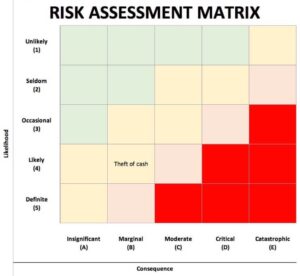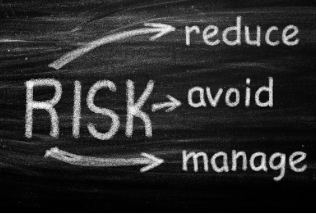What is a Risk Assessment Matrix?
Risk Assessment Matrix and its Benefits
So firstly, what is a risk assessment? A risk assessment identifies and evaluates the threats and risks of a certain situation. Potential hazards are inevitable, however, if you are aware of a potential hazard, it is better and easier to either reduce the harm it causes or where possible prevent it completely than to deal with the consequences.
Is it vital to carry out risk assessments in all organisations, there are moral, legal and financial benefits to conducting risk assessments.
Step 1: Identify Hazards.
Identifying potential hazards may take some time as the list needs to be comprehensive. It may include anything from falls and burns to theft and fraud to pollution.
These are common classifications of hazards:
- Physical: e.g. lifting, awkward postures, slips and trips, noise, dust, machinery, computer equipment, etc.
- Mental: e.g. excess workload, long hours, working with high-need clients, bullying, etc. These are also called ‘psychosocial’ hazards, affecting mental health, and occurring within working relationships.
- Chemical: e.g. asbestos, cleaning fluids, aerosols, etc.
- Biological: including tuberculosis, hepatitis and other infectious diseases faced by healthcare workers, home care staff and other healthcare professionals.
Step 2: Decide Who May be Harmed, and How.
Identifying who is at risk starts with your organisation’s own full- and part-time employees, this includes agency and contract staff, visitors, clients and other members of the public on their premises.
Employers must review work routines in all the different locations and situations where their staff are employed.
Step 3: Assess The Risks and Take Action.
This means employers must consider how likely it is that each hazard could cause harm. This will determine whether or not your employer should reduce the level of risk. Even after all precautions have been taken, some risk usually remains. Employers must decide for each remaining hazard whether the risk remains high, medium or low.
Step 4: Make a Record of the Findings.
Employers with five or more staff are required to record in writing the main findings of the risk assessment. This record should include details of any hazards noted in the risk assessment, and any action taken to reduce or eliminate risk.
This record provides proof that the assessment was carried out and is used as the basis for a later review of working practices. The risk assessment is a working document. You should be able to read it. It should not be locked away in a cupboard. This is where OpsPal can help. OpsPal allows risk assessments to be stored on the cloud to be viewed at any time. These risk assessments can be easily updated and sent to all employees that they relate to, the staff can then read and agree that they understand them. This allows the business to have a full audit of what risk assessments have been updated, read and understood.
Step 5: Review the Risk Assessment.
A risk assessment must be kept under review in order to:
Ensure that agreed safe working practices continue to be applied (e.g. that management’s safety instructions are respected by supervisors and line managers); and take account of any new working practices, new machinery or more demanding work targets.
The beauty of OpsPal is that it allows you to update and resend risk assessments easily. This is particularly helpful in times such as Covid-19 when things were changing so often.
Step 6: Create a Risk Assessment Matrix
A risk assessment matrix simplifies the information from the risk assessment form, making it easier to pinpoint major threats in a single glance. This convenience makes it a key tool in the risk management process.
Every risk assessment matrix has two axes: one that measures the consequence impact and the other measures likelihood.
To use a risk matrix, extract the data from the risk assessment form and plug it into the matrix accordingly.
Green is low risk
Yellow is medium risk
Orange is a high risk
Red is an extreme risk

Next Steps & Responding to Risks
Once you have finished your plan, determine what steps to take next and how to action them.
Your risk assessment is an ongoing evaluation and must be reviewed regularly. Experts recommend updating your risk assessment at least once a year, and perhaps more often depending on your unique situation. With OpsPal you never need to remember when the next review date is as it tells you in advance, then you simply need to review and update them if needed which can be done instantly. Then it’s easy to send a read request around to everyone who needs to read it.
For more information on how OpsPal can help your business book a demo and consultation here https://opspal.co.uk/book-a-consultation/











